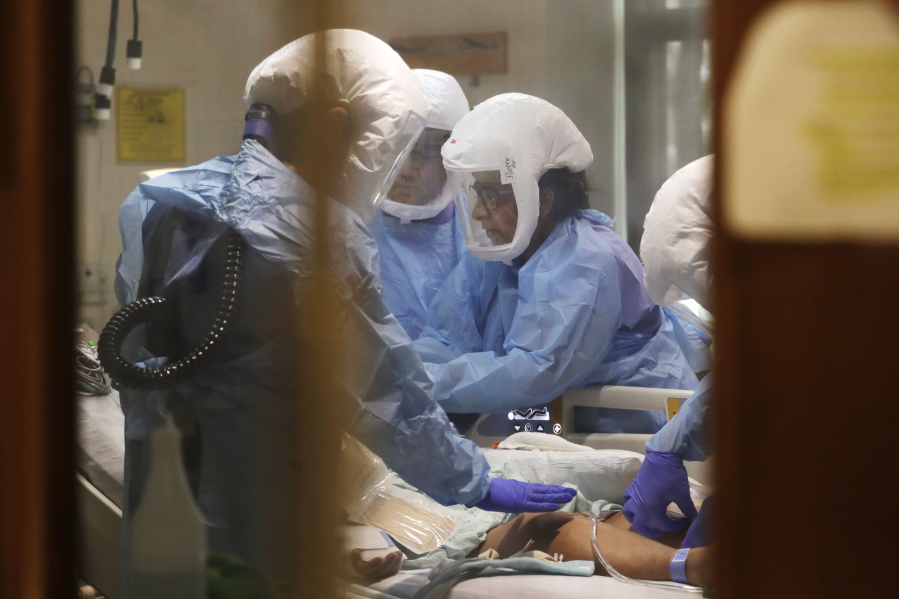Washington’s hospitals are again “dramatically over capacity,” as challenges discharging patients worsen and staff shortages persist, the state’s health care leaders said Monday.
In a news briefing, leaders from the Washington State Hospital Association said many health care facilities are 120% to 130% full, leading to long wait times in emergency departments, declining patient care and disruptions in ambulance services throughout the state. The high patient loads aren’t directly due to COVID-19 cases: Instead, officials say delayed procedures and difficulties discharging hospital patients are behind the capacity problems.
“We are doing our best, but many of our hospitals — especially in the west side of our state in the populated areas of King, Pierce and Snohomish counties — are more strained today than really at any other point since the pandemic began,” said Dr. Steve Mitchell, medical director of Harborview Medical Center’s emergency department and the Washington Medical Coordination Center.
At Swedish Health Services, about 17% of patients no longer require hospital care, chief nursing officer Kristy Carrington said during the briefing. More than 100 similar patients are also waiting to be discharged at Harborview Medical Center, which is operating at 130% capacity. At MultiCare Health System, based in Tacoma, staffers are caring for another 180 patients who could be discharged.
While these patients still require some type of care, they’re not sick enough to remain in a hospital bed and are better suited to continue recovering at post-acute care facilities, like skilled nursing homes or long-term care centers, Mitchell said. Those types of facilities, however, are also battling staffing holes and are often unable to take on more patients.
As a result, some of these post-acute patients stay in the hospital for months, Carrington said.
“The environment within the hospital is really not designed to care for these people who need that long-term care,” she said. “It’s not the best setting for them to have that healing care. They’re not able to go outside or have those same types of activities they’d be able to have in a different type of post-acute facility.”
And while COVID has had less of direct impact on hospital capacity recently, infections and hospitalizations are still rising as the virus’s infectious BA.5 subvariant continues to spread through the state. In addition, COVID patients make up about 12% of the state’s hospital beds, a sizeable jump from about 3.5% in early April, according to the state’s COVID data dashboard.
Further complicating the discharge process, Washington’s guardianship laws prohibit a patient’s family member or close friend from consenting on the patient’s behalf (if the patient is incapacitated or unable to consent) to move them from a hospital to a long-term care facility. If the patient hadn’t already appointed their decision maker in a power of attorney document, state law requires a court-appointed guardian, which is a lengthy process, said WSHA vice president Taya Briley.
“We are unique in the nation in our state taking this position about the required appointment of a guardian and we are feeling that pain across our health care system,” Briley said. “It is not a practical way to move patients through the system.”
Overcrowded hospitals and a lack of staffed beds are also creating disruptions in the state’s ambulance services, said Steve Brooks, fire chief of Lacey Fire District 3 and president of Washington Fire Chiefs.
Now, long wait times are common across the state for paramedics who arrive at hospital emergency departments with a patient, Brooks said. So far, the longest an ambulance crew has had to wait to admit a patient is about 4 1/2 hours, he added.
“Literally all the available beds were taken up,” Brooks said.
The state’s fire chiefs association encourages people to try telehealth or urgent care clinics, unless the emergency room is absolutely necessary. But Brooks acknowledged some accessibility and financial barriers remain.
Hospital leaders have long asked state officials to step in and address discharge and staffing issues with measures like reconsidering interpretation of the state’s guardianship laws, but change has been slow-moving, Briley said.
“We have solutions that we know will decant the system,” she said. “We need to make sure these strategies are being deployed as quickly as they can be to support the acute care part of the system so folks can get the care they need when they need it.”



